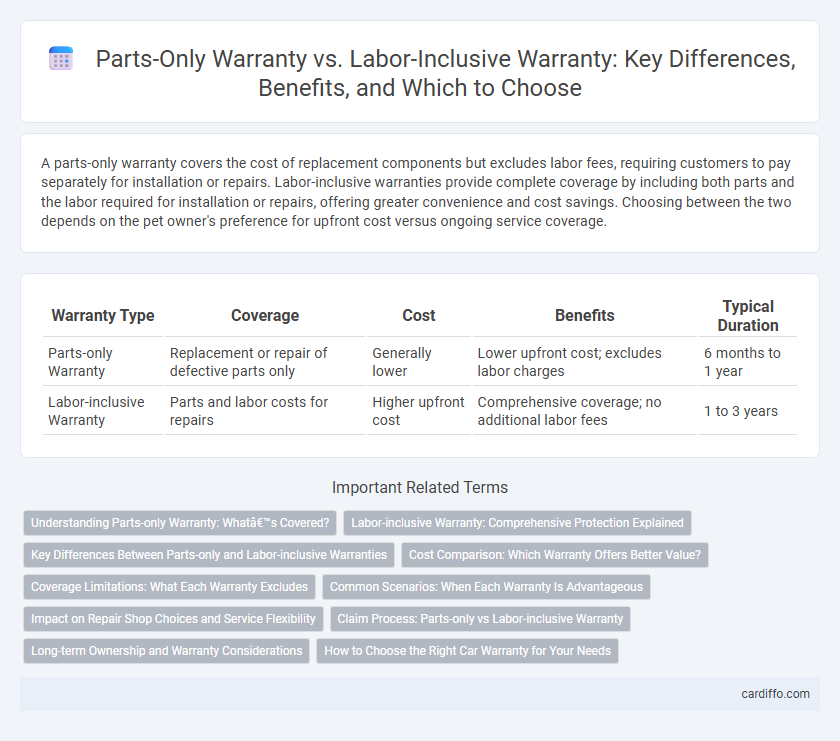A parts-only warranty covers the cost of replacement components but excludes labor fees, requiring customers to pay separately for installation or repairs. Labor-inclusive warranties provide complete coverage by including both parts and the labor required for installation or repairs, offering greater convenience and cost savings. Choosing between the two depends on the pet owner's preference for upfront cost versus ongoing service coverage.
Table of Comparison
| Warranty Type | Coverage | Cost | Benefits | Typical Duration |
|---|---|---|---|---|
| Parts-only Warranty | Replacement or repair of defective parts only | Generally lower | Lower upfront cost; excludes labor charges | 6 months to 1 year |
| Labor-inclusive Warranty | Parts and labor costs for repairs | Higher upfront cost | Comprehensive coverage; no additional labor fees | 1 to 3 years |
Understanding Parts-only Warranty: What’s Covered?
Parts-only warranty covers the cost of replacement components but excludes the expenses related to labor for installation or repair. This type of warranty typically applies to specific parts prone to failure, offering protection against manufacturing defects or malfunctions. Understanding the limitations of parts-only warranty ensures consumers are aware they may incur additional out-of-pocket costs for professional repair services.
Labor-inclusive Warranty: Comprehensive Protection Explained
Labor-inclusive warranties provide comprehensive protection by covering both the cost of replacement parts and the labor required for repairs, ensuring no out-of-pocket expenses for the consumer during the warranty period. This type of warranty is particularly valuable for complex or labor-intensive repairs where labor costs can significantly exceed the price of parts. Choosing a labor-inclusive warranty enhances peace of mind, as it guarantees full coverage for repairs, minimizing unexpected expenses and maximizing long-term investment protection.
Key Differences Between Parts-only and Labor-inclusive Warranties
Parts-only warranties cover the replacement or repair of defective components but exclude labor costs, making them a cost-effective option for consumers who can manage installation independently. Labor-inclusive warranties provide a more comprehensive solution by covering both parts and the associated labor expenses, ensuring professional service without additional out-of-pocket charges. Key differences include the scope of coverage, potential out-of-pocket costs, and overall value, with labor-inclusive warranties offering greater convenience and protection against unexpected repair bills.
Cost Comparison: Which Warranty Offers Better Value?
Parts-only warranty typically involves lower upfront costs but can lead to higher out-of-pocket expenses due to labor fees during repairs. Labor-inclusive warranty usually comes with a higher initial price yet reduces unexpected expenses by covering both parts and labor, offering greater financial predictability. Evaluating the total cost of ownership based on repair frequency and labor rates helps determine which warranty provides better value for specific needs.
Coverage Limitations: What Each Warranty Excludes
Parts-only warranty excludes labor costs, limiting coverage solely to replacement parts and often omitting shipping or handling fees. Labor-inclusive warranty covers both parts and the associated labor charges required for repairs, providing more comprehensive protection. Neither warranty typically covers damage from misuse, wear and tear, or unauthorized repairs, highlighting coverage limitations in both types.
Common Scenarios: When Each Warranty Is Advantageous
Parts-only warranties are advantageous for customers with the skills or resources to perform repairs themselves, minimizing upfront costs by covering only replacement parts. Labor-inclusive warranties benefit those without technical expertise or access to repair services, as they cover both parts and repair labor, reducing unexpected expenses. In frequent use or commercial settings, labor-inclusive warranties offer greater value by ensuring comprehensive coverage and minimizing downtime.
Impact on Repair Shop Choices and Service Flexibility
Parts-only warranties limit repair shops to replacing defective components without charging labor, which can reduce the shop's revenue and discourage in-depth diagnostics or repairs. Labor-inclusive warranties provide repair shops the flexibility to bill for both parts and labor, encouraging more comprehensive service and potentially higher customer satisfaction due to thorough repairs. The choice between these warranty types influences how repair shops prioritize service quality, operational costs, and customer engagement strategies.
Claim Process: Parts-only vs Labor-inclusive Warranty
Parts-only warranty claims typically require submitting proof of part failure and often involve fewer steps, as the coverage excludes labor costs. Labor-inclusive warranty claims demand detailed documentation of both the defective parts and the labor performed by authorized technicians, which may result in a more complex approval process. Understanding the claim submission requirements and documentation differences is crucial for efficient warranty service under each coverage type.
Long-term Ownership and Warranty Considerations
Parts-only warranty covers the cost of replacement parts but excludes labor charges, potentially increasing out-of-pocket expenses over time for vehicle owners. Labor-inclusive warranty offers comprehensive coverage, reducing unexpected repair costs and providing greater financial predictability for long-term ownership. Evaluating warranty terms based on typical repair frequency and labor rates is essential for maximizing cost-efficiency and vehicle maintenance planning.
How to Choose the Right Car Warranty for Your Needs
Choosing the right car warranty depends on your budget and how you plan to maintain your vehicle; parts-only warranties cover replacement parts but exclude labor costs, making them suitable for those who can manage repairs independently or have access to discounted labor. Labor-inclusive warranties provide comprehensive coverage, encompassing both parts and labor fees, which is ideal for individuals seeking hassle-free repairs and predictable expenses. Assess your driving habits, vehicle age, and repair cost tolerance to determine whether a parts-only or labor-inclusive warranty aligns better with your needs and financial plan.
Parts-only Warranty vs Labor-inclusive Warranty Infographic

 cardiffo.com
cardiffo.com